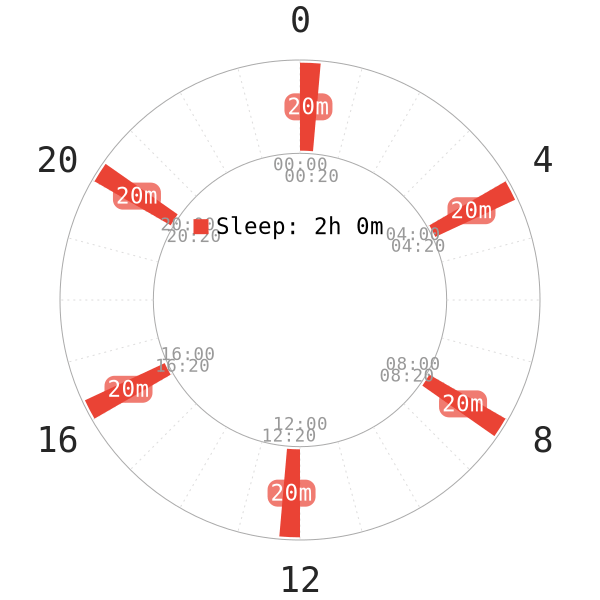
Uberman is the most widely known form of polyphasic sleep. Its main appeal is the large amount of extra wake time it provides. For this reason, many first-time polyphasers have attempted this schedule. Sadly, due to its extreme difficulty or likely impossibility for people with normal genetics, almost all of these attempts end in failure.
If you are still interested in attempting this schedule, this page can prepare you for the grueling sleep deprivation and increase your chance of success.
Content
- History
- Difficulty
- Mechanics
- Theory
- Adaptation Difficulty
- Adaptation Routes
- Alternate Variants
- Lifestyle Considerations
History
Marie Staver (Puredoxyk) named this sleep pattern Uberman. She and Psuke Briah attempted it in 1999; this drew inspiration from a TIME article about Buckminster Fuller’s Dymaxion sleep. A post on everything2.com in 2000 first revealed its existence.
Difficulty
Both Steve Pavlina’s blog and Puredoxyk’s book Ubersleep do not convey the true extent of difficulty of the Uberman schedule.
- The first edition of Ubersleep claimed that adaptation to Uberman would take 1 week; people would start to feel great after two (Ubersleep 1st edition).
- This was later revised to state that people feel better after one week and perfect after 30 days in the second edition (Ubersleep 2nd edition).
Puredoxyk on Uberman’s Difficulty
Puredoxyk later elaborated on this issue in response to many people getting the impression that Uberman adaptation was hard only for a week.
“ 1. Yeah WOW Uberman is NOT EASY and I have no idea where the “it’s only hard for a week” thing keeps coming from; it’s not me, at least not intentionally. I swear. I’ve consistently tried to err on the side of “no dude this is REALLY HARD”, and I don’t know, it just doesn’t stick with people. Frankly I suppose it’s probably because “anybody can do this!” is such a better selling answer.
And, like, I’m sure 99.99% of all individual people could do it, with the right motivations and circumstances; but 99% of those won’t, and don’t really want to even if they think they do.”
(excerpt of Puredoxyk in Ubersleep Slack, posted 14.1.2018, accessed 3.10.2018)
Puredoxyk on How A Complete Uberman adaptation Feels
“I’ve adjusted that number over time after pondering and thinking – when I first did this, I was so amazed when I stopped feeling UTTERLY HORRIBLE that I think I told myself, “Whee, it’s done!” at the time. In retrospect, though, there were definitely still some minor struggles ahead, and even at the time, when people asked me how long it took to feel FULLY used to it, I said 30-45 days.
Another reason my accounts sounds conflicting sometimes is….what does it MEAN to be 100% sleep-dep free? When I did Uberman I’d been experiencing sleep dep as a norm for most of my life. On day 10, I felt so good compared to the insomniac train-wreck that was my sleep previously that I declared a miracle / full recovery from adaptation on the spot.That was also the point where I felt good enough to decide that yup, I wanted to do this in the long-term. But was I actually fully adjusted with no further tired sport and full ease of sleeping at the time on day 10, no way. Things were over the line of “good” by then, but it took the usual month for habits to really form before it got fully non-sleep deppy.”
(excerpt of Puredoxyk in Ubersleep Slack, posted 14.1.2018, accessed 30.9.2018)
She only stayed on the schedule for 6 months and was not able to re-adapt to it. Nevertheless, people tend to overestimate their chances of succeeding; the success rate to date is extremely low. The number of unfinished adaptation logs on reddit, YouTube and numerous blogs speak volumes about the failure rate.
Furthermore, the polyphasic Discord also has a 0% success rate of anyone who actively logged their attempts.
Uberman’s Fragility
The inflexibility of the napping slots further increased the difficulty of the schedule.
- For one, it is extremely challenging to skip a nap:
“It’s very noticeable, especially if I miss a nap; within an hour of naptime, I’ll feel like a monophaser who got shorted by several hours the previous night. (On Uberman, missing a nap made me miserable for most of a day; I’d feel sleep-deprived within half an hour; it would sometimes take several regular naps to catch up.) You go from zero to sleep deprivation very quickly on a polyphasic schedule, because you’re squeezing more rest out of less sleep.”
(Ubersleep page 57, second ed.)
– Ji: “Flexing naps instead is likewise vey limited. Puredoxyk was only able to move naps by about 5 minutes forward and backward even after adaptation. “Because Everyman has a core sleep and, after adapting, its naps are fairly flexible. Uberman, on the other hand, is extremely strict. A nap at 8.30 will always be at 8.30, maaaaaaybe at 8.35.”
– Puredoxyk: “++ those were really good answers for William, the group thanks you!”
(excerpt conversation from Ubersleep Slack, posted 24.7.2018, accessed 27.10.2018)
- Puredoxyk also reported feeling sleep deprived for the next few waking periods after just one altered nap. (Ubersleep, p. 57).
- Along with the wake blocks being only 3h40m each, Uberman is unsustainable for most people. It is very hard to schedule all daily tasks and events around it.
A Uberman Experience from a Discord User
- Two people who spent an extensive period of time on the schedule, Aeia (YouTube) and DontPanic (Discord), also reported insidious fat gain and physical deterioration.
“The Uberman schedule really isn’t sustainable long term. Mentally, it is very resting, but it becomes physically exhausting. The naps become very deep and very hard to wake from, at times worryingly so. [….] But like, working out was hard and I got no gains.”
(excerpt of DontPanic from Polyphasic Sleeping Discord, posted 17.2.2017, accessed 19.11.2018)
Mechanics
- Since REM and SWS cannot go below certain levels without ill effects, all naps must account for SWS and REM sleep. This is problematic because most humans require at least ~90 minutes of SWS and REM each while Uberman only totals 2 hours.
- It is very likely that only a very small percentage of people can reduce their SWS and REM sufficiently to sustain Uberman.
- The extremely low total sleep time leads to intense sleep cycle compression and repartitioning. These processes possibly reduce the cycle lengths to under 60 minutes (this is as of yet unconfirmed).
- After adaptation, falling asleep becomes almost instant and the transition to REM or SWS would also be almost immediate. In return it gives merely minutes of light sleep. This would allow up to about 1h50m of REM and SWS combined.
Theory
Living on this schedule requires constant maintenance of a delicate balance between REM and SWS pressures.
- Throughout each waking block, REM and SWS pressures build up gradually to very high levels and drop to more reasonable levels during the course of a nap.
- The naps would primarily contain the sleep type with higher pressure (either due to homeostatic pressure or circadian rhythm or both).
- Then, this typically reverses the ratio between REM and SWS pressures, so that the other sleep type dominates the following nap. It is also common to experience mixed-stage naps with both REM and SWS. This is the body’s effort to mitigate the ridiculous sleep pressure.
So far, only a few people have managed to stay on this schedule for over a few months, due to aforementioned social and physiological difficulties.
- Because of this schedule’s strong reliance on high sleep pressure, any oversleep will greatly set back the adaptation.
- Just one extended oversleep is enough to completely reverse the adaptation, even after months following the schedule.
- Discord user DontPanic could not recover his Uberman rhythm after his 9-hour crash after 2 years on the schedule. Hence, it is doubtful if a truly complete adaptation is even possible.
- It might also not be possible to do intense exercise on Uberman (particularly anaerobic) since doing so incurs additional SWS needs1.
- It would also be nearly impossible to stay on this schedule with sickness, since it also increases SWS and sleep needs2. Sleeping for long sessions for recovery would also negatively affect the adaptation.
Adaptation
As explained above, adapting to Uberman is extremely difficult. While some people may claim that there is an easier method, that is not the case. Any methods of adapting to this schedule involve prolonged and intense sleep deprivation to produce the insane level of sleep compression.
Adaptation Process
Below are the possible steps that sleepers go through during an Uberman or nap-only adaptation. Note that the mileage may vary between individuals.
- Without previous napping experience, naps will mostly contain light sleep or traces of SWS.
- As REM need is below the usual requirements, REM pressure quickly builds up to high levels. This also causes REM to start very early in the naps. Sleepers can expect this phenomenon to happen around day 3-5. Sleep deprivation appears to be in control, which makes people overconfident about the adaptation.
- Naps mostly contain REM, and SWS pressure starts to build. Initiation of SOSWS usually occurs on day 7-8 and it is the hardest part of the adaptation. This is where most people start to oversleep and fail their adaptation.
- If they manage to avoid the first crash, they will also need to avoid subsequent crashes once every 2-3 days. Oversleeping every 2-3 days can become common as the surprising recovery from each oversleep inspires hubris and continued failure.
- If they can ultimately overcome all potential oversleeps, REM and SWS pressures gradually reach an equilibrium.
- The schedule is finally stable. This can take up to 6 weeks, without any oversleeping.
Alarms
It is important to realize that willpower alone is not enough to adapt to this schedule.
- With SWS deprivation, willpower is essential but not enough on its own. People have reported unconsciously disabling or ignoring electronic devices and performing other actions necessary to go back to sleep. They also have no recall of doing so afterwards.
- Most notably, they have also slept through noise-based alarms, flashing lights, loud fans, and repeated maximum-voltage shocks from a Pavlok.
Thus, it is very useful, if not necessary, to have constant human supervision to make sure you are awake when you are supposed to be. Psuke helped Puredoxyk and Aeia’s twin sister assisted her during their Uberman adaptation. Pavlina’s wife also helped him out.
Without the help of other people, it is extremely unlikely that you would ever adapt to this schedule.
Routes to adaptation
Delaying SOSWS
It is possible to delay the early SOSWS initiation by a few days by adding extra naps in the night for extra SWS gain during the first days of adaptation. Steve Pavlina used this method to delay his SWS naps until around day 12.
It is not generally a good idea though, since the SOREM naps will eventually happen. The oversleeps will drag out the adaptation process by several days. Overcoming the SWS-heavy naps is essential to Uberman adaptation.
Gradual adaptation via rhythmic preservation
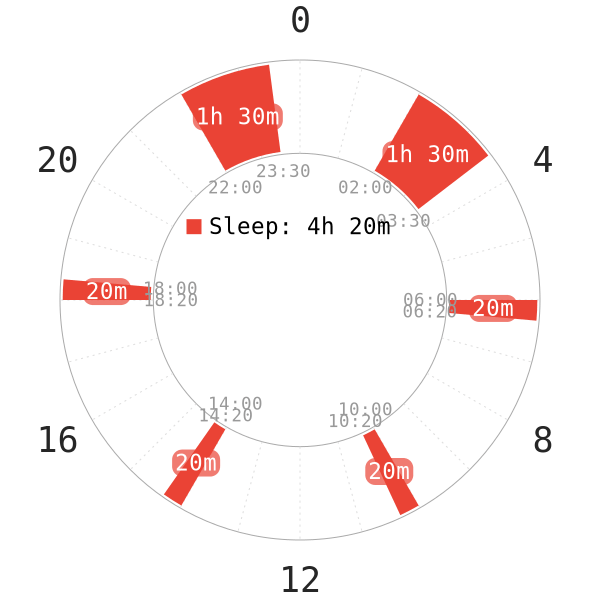

These are possible transition schedules to Uberman with sleeps blocks that start at the same time as on the desired Uberman schedule.
- It might train the bodily rhythms to align the tiredness dips with Uberman naps.
- This could reduce the transition difficulty. Still, intense compression and repartitioning will be mandatory at each transition, especially the final jump to Uberman.
- With two transitions, the cumulative adaptation becomes several months long with only some reduced difficulty. Overall, this may not be worth the extra time for adaptation.
Naptation/Staying awake before starting
This methods involves staying awake for 1-2 days to quickly increase sleep pressure or start with naps every 2 hours instead of 4. This serves to quickly acquire the ability to gain REM during naps.
Scheduling Variations
Uberman 7 (U7), Uberman 8 (U8)

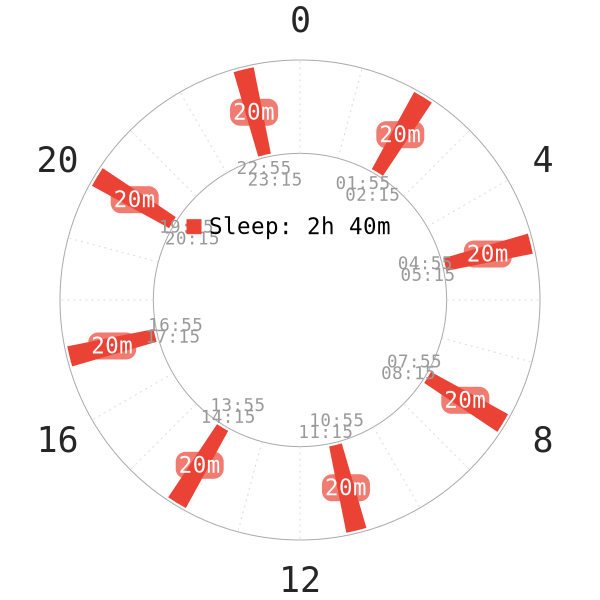
- Having one or two extra naps might make Uberman more sustainable for people. This is because 2h is far below the minimum requirements of an average person.
- The extra naps may lower the adaptation difficulty.
However, this is even less realistic socially since 3h5m and 2h40m wake blocks are too short to be practical. No one has adapted to these alternative Uberman schedules, though.
Shorter naps
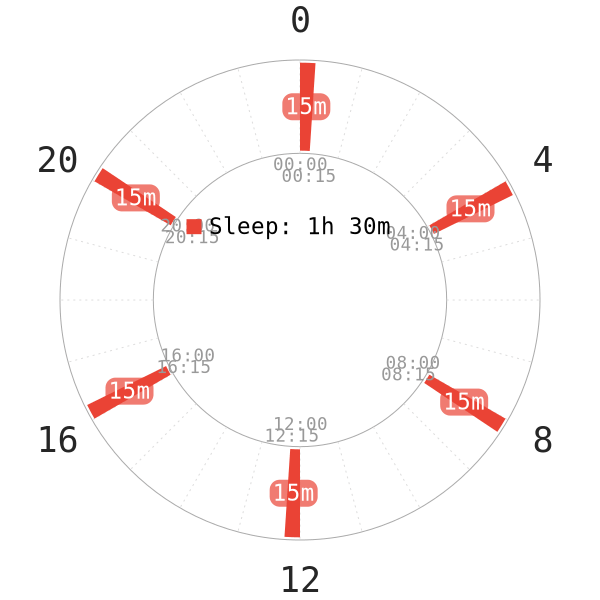
Leonardo Da Vinci’s Uberman
It is said that Leonardo Da Vinci lived with this Uberman variant for most of his life. However, there is absolutely no concrete evidence for his case. Da Vinci’s life was devoted to various legendary inventions; thus, it seems to make sense that such a genius mind would probably require an abnormally low amount of sleep to create all the brilliant works in his lifetime.
However, Claudio Stampi, a polyphasic sleep researcher, has disputed that Da Vinci followed this Uberman variant. The scarcity of evidence among the science of sleep that is only at the fledgling stage unfortunately fails to fully confirm this “myth”. Interestingly, many casual online users also believe that Da Vinci followed the Uberman schedule.
Successful adaptation
Nevertheless, there was an anecdotally successful Uberman sleeper at the end of the 1950s (Chapter 11 of Why We Nap). This sleeper recounted his adaptation to this Uberman variant in the journal. The total sleep was a measly 1h30m each day, mirroring the alleged Uberman variant of Da Vinci. It did take him 25 days to adapt, and he remained on it for a couple months.
However, like many other anecdotal accounts about the quirks of Uberman long-term, the artist’s creativity sharply declined because he barely recalled dreams from the Uberman naps anymore. Vivid dreaming had been inspiring his artwork, yet his dream recall ability took a turn for the worst. This happened even after the adaptation phase was allegedly complete.
There were two reasons for this dream recall deficit:
- The malleability of SWS and REM pressure changed; after several months, his naps had little room for REM sleep while trying to redeem the necessary amount of SWS to fuel his daily performance.
- REM deprivation resulted from the loss of dream recall. The discomfort kept rising and irritated him. The lack of REM sleep can lead to negative mood change, after all.
This last straw eventually forced him to drop the schedule. He was able to sleep 8h monophasically after the Uberman attempt, with little to no repercussions to total sleep time. However, he was a moderate insomniac, which may play into his short-lived adaptation success.
Given the absurdity of this Uberman variant, it would be better to just adapt to the standard variant.
Uberman with denser nighttime naps (U6-modified)
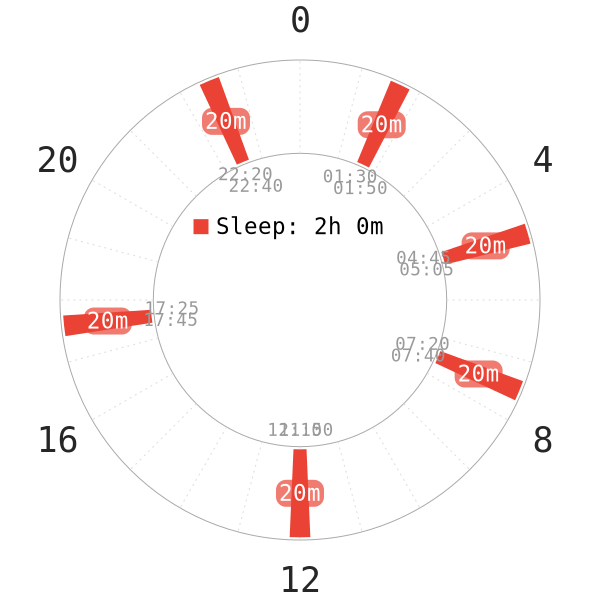
- Here, more naps concentrate around the night since sleep pressure is generally higher during nighttime.
- It would also be easier to schedule events around longer daytime gaps.
However, it is very difficult to stay awake for long periods of time on Uberman due to the total sleep. This setup is likely even harder than the standard equidistant Uberman. No one has adapted to this, either.
If you or someone you know has sustained a nap-only schedule for longer than 2 months or have some helpful tips from your own adaptation, please contact the admin team to help add to our knowledge! You can do so either by email ([email protected]), Discord or Reddit.
Research
Interested in some research on Uberman sleep? Refer to this to find out!
Lifestyle Considerations
Based on the official research, it now becomes clear what downsides Uberman suffers:
- Virtually no room for exercising
- Very constrained social life which makes long-term sustenance unviable
The cons vastly outweigh the pros, which are large sleep reduction and powerful dreaming. 3h40m wake period between each nap is usually too short to schedule real-world commitments; Steve Pavlina worked from home and Puredoxyk was only a student during their adaptations. Therefore, only work-from-home lifestyles would benefit from an Uberman adaptation.
Further issues
From the community’s standpoint, there are more glaring issues with Uberman:
- There is little mercy on skipping a nap. Doing so further develops the chance for a long crash during adaptation.
- Even after adaptation, risk of oversleeping remains, and many alarms remain important for several months.
- Inflexibility of sleep even after adaptation.
- High likelihood for obnoxious weight gain due to several metabolic factors from radically reduced sleep
- Like any other nap-only schedules, Uberman does not support the glymphatic system well, because the longest sleep duration is only 20 minutes. The clearance of brain waste usually requires ~60m of uninterrupted SWS to clear out brain toxins efficiently.
- There could be some hidden mechanics behind the intensely deep naps that facilitate this biological process; yet, it is currently unknown how because this schedule cannot preserve an average SWS baseline per day (~90m).
- The research also confirms how difficult to sustain Uberman by reflecting on the minuscule adaptation success. Even if adaptation is going in one’s favor, many factors can prompt a forfeit, such as social life and sickness.
Conclusively, only sleep mutants and heavy insomniacs should attempt Uberman. Other than that, Uberman should only be used as an emergency schedule for a short period of time before recovery.
Main author: Zandimna & GeneralNguyen
Page last updated: 8 April 2021
Reference
- Shapiro C, Bortz R, Mitchell D, Bartel P, Jooste P. Slow-wave sleep: a recovery period after exercise. S. 1981;214(4526):1253-1254. doi:10.1126/science.7302594. [PubMed]
- Imeri L, Opp MR. How (and why) the immune system makes us sleep. N. 2009;10(3):199-210. doi:10.1038/nrn2576. [PubMed]

This probably very infeasible, but I have a dream of achieving UberNight (5-6 naps during the night, ~1 hour apart, awake during the day with an optional nap). If it could be done, it would be just like a regular sleep schedule but with secret time in the middle. I just started really looking into polyphasic sleep *today* so this is probably extreme madness, and I won’t be able to properly attempt anything like this for quite a while, but it’s very exciting to consider.
I have learn several just right stuff here. Definitely worth bookmarking for revisiting. I wonder how so much attempt you put to make any such wonderful informative website.
I simply wanted to appreciate you all over again. I am not sure what I would’ve done in the absence of the actual creative ideas shown by you relating to this topic. It truly was a real intimidating circumstance in my position, nevertheless taking note of this specialized approach you dealt with the issue took me to cry with delight. I am happy for your assistance and hope you find out what a powerful job you are always providing training the rest thru your web blog. Most probably you have never got to know all of us.